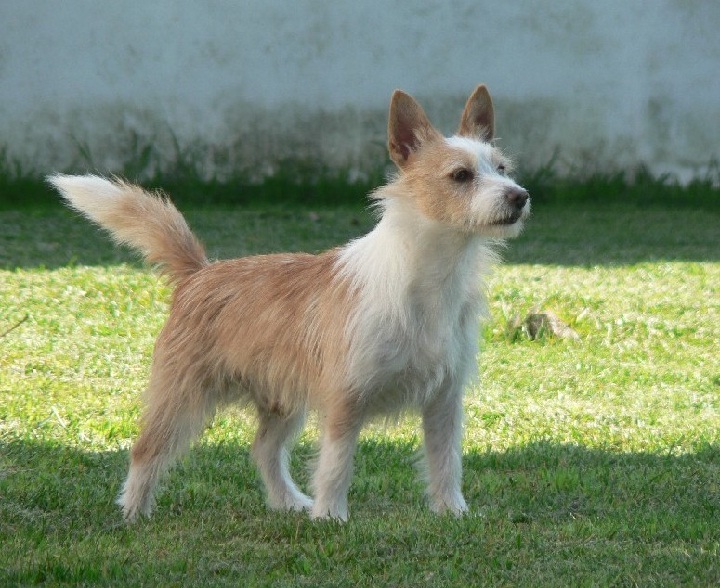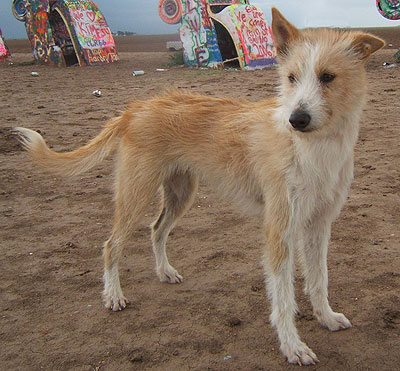
#PORTUGUESE PODENGO PEQUENO FULL#
The mouth closes in a normal scissors bite with full dentition required in the large variety. They are set level with the eyes but tilt slightly forward. The triangular shaped, thin, erect ears are vertical and fairly long and very mobile. The eyes are small and slanted, their colour ranging from honey to brown, corresponding with the coat colour. The nose, which is prominent at the tip, should be a darker colour than the coat. The lips are tight fitting, thin and firm, horizontally cut and well pigmented. The stop is not defined but the muzzle with its straight profile, is shorter in length than the skull.

The head is wedge-shaped, with flat skull, prominent occiput and clean cheeks. The Portuguese Podengo TodayĪ primitive type dog, The Portuguese Podengo comes 3 sizes and 2 coat types, namely short and smooth or long and wire. They were recognized by the FCI in 2008 and Australia in 2011. Today they are still classified into these 3 sizes and 2 coat types. This was published in the 'Portuguese Origins Book' in 1956. Then several cynologists and veterinarians worked on the classification into 3 sizes and 2 coat types with the Breed Standard approved by the Portuguese Kennel Club in 1954. At first all 6 varieties were classified as the same breed. Podengos have been exhibited in Portugal since their first Canine Exhibitions in 1902. Once the rabbit is on flatter ground, the Podengo (Medium) continues the chase. Podengos (Small) are capable of great bursts of speed which enables them to catch rabbits on the run. If the dog had a white tipped tail, it could be distinguished easily from from its quarry in long grass and brush. This attracted hunters to the rabbits' warrens but unlike Terriers, the Podengo did not usually enter these dens.

The Podengo (Small) worked close to the hunter on foot, sounding his voice when he found the entrance to a rabbit warren, especially when it was hidden within the crevices of tiny rock ledges. But his claim to fame was as a rabbit hunter when he worked side-by-side with the Podengo (Medium). Today the Podengo (Small) is also used to catch rats, mice and other vermin. So, the Podengo (Small) has been developed as a separate breed to the Podengo (Medium) and the Podengo (Grand), with no inter-breeding between these varieties allowed. Because there is a 4-inch gap between their height at shoulder to the Portuguese (Medium) and even more to the Podengo (Large), inter-breeding between the Podengo (Small) and the other two varieties is unfeasible. Today, the Podengo (Large) and the Podengo (Medium) are allowed to be interbred.īut the Podengo (Small), also known by its Portuguese name Pequeno, is a different story.

By the 1960's there was a consolidation of yellow as the dominant colour with the disappearance of black which had plagued dogs in some villages. The Podengo (Medium) were rabbit hunters. By the 1970's the Podengo (Large) had also almost disappeared, but was revived in the 1980's together with the revival of some boar hunting in Portugal. By the 1960's, wild boar hunting which had been such a tradition in Portugal for around nine centuries, had all but disappeared.

The Portuguese Podengo becomes a Pure Breed Hence the evolution of the natural, primitive, utilitarian character of today's Podengos and why they were also known as Portuguese Warren Dogs. These depict pricked eared dogs with a hare or rabbit their mouths.
#PORTUGUESE PODENGO PEQUENO PLUS#
This subsistence consisted of food to eat plus skins to provide primitive clothing and shelter.įrom 1,000 - 1,100 A.D, dogs that hunted rabbits became so legendary they were portrayed on friezes (carved images) of buildings and in other artworks in Portugal. Before Portugal had any significant population, these dogs assisted early settlers to hunt indigenous animals to stay alive. These looked somewhat like today's Canaan Dogs, probably brought from Africa to Portugal by sea-faring Phoenicians. Thousands of years ago, the Podengo was developed from Pariah or primitive dogs. These 6 separate varieties hunted in different terrains within the local areas across Portugal. Each of the three sizes - large, medium and small come with both smooth and wire coat types. This primitive breed hunts not only with sight and scent, but also with its extraordinarily keen sense of hearing. A relative newcomer to Australia, the Portuguese Podengo or Portuguese Warren Hound, is an ancient breed and Portugal's 'National Dog'.


 0 kommentar(er)
0 kommentar(er)
